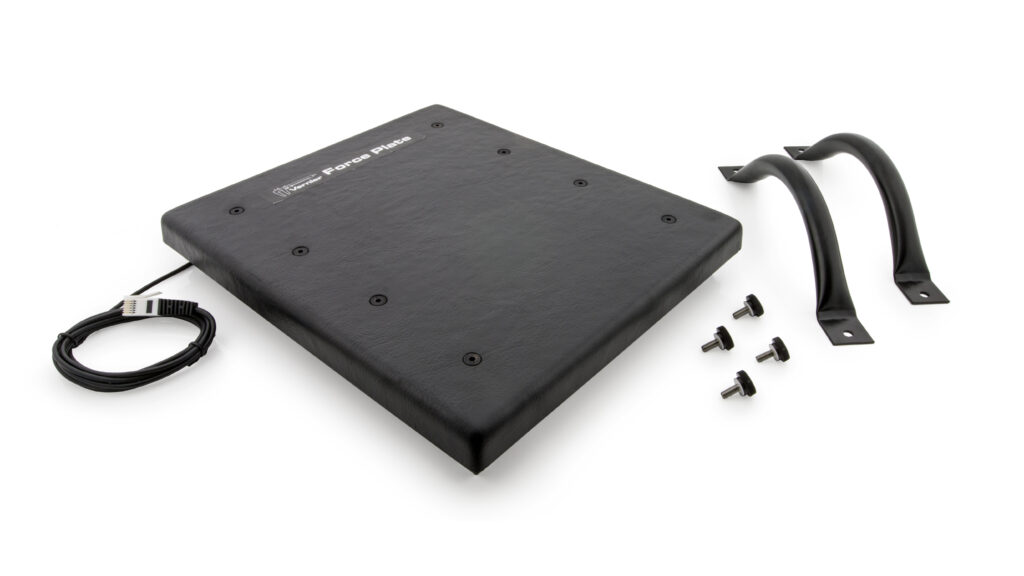Force Plate (FP-BTA)
Specifications and User Guide


Revised unit shipping after November 10, 2023
Original unit shipping prior to November 10, 2023
TROUBLESHOOTING
-Primary Test: Set the range switch, located on the same side of the force plate as the cable, to the 3500 N range. Reset the data-collection program by starting a new experiment file to access the appropriate calibration equation for the range setting. Does the plate read approximately zero? Choose Zero in software. Stand on the plate; using F=mg, does the reading make sense?
-Secondary Test: Changing the physical orientation of the sensor will change the reading when no force is applied. Use the tools in the data-collection program to zero the sensor.
The most common failure mode of the original version is to have the plate not respond to changes in the force. This may be seen as a constant -1000N or +4000N reading when on the 3500 N range. If the force plate does not respond at all to a change in force, check that the range switch is moved all the way to the side on the 3500 N range, and not in the middle. If plate still does not respond, contact Technical Support. Call 888-837-6437 or email support@vernier.com.
It is common for the force plate to exhibit some hysteresis (on the order of a few newtons) after hard impacts.
The original Force Plate and the revised Force Plate have different factory calibration equations due to the different load cells used. If you are using this sensor with other programming languages you will need to verify which calibration equation to apply to the output voltage.
| Original Force Plate | Slope (gain): 1000 N/V or 250 N/V Intercept (offset): -1000 N or –250 N Force = Vout* 1000N/V – 1000 N (3500 N range) Force = Vout* 250 N/V – 250 N (850 N range) |
| Revised Force Plate | Slope (gain): 850 N/V or 207 N/V Intercept (offset): -550 N or –135 N Force = Vout* 850N/V – 550 N (3500 N range) Force = Vout* 207 N/V – 135 N (850 N range) |
RELATED TIL ENTRIES
What activities are available for the Force Plate?
My Force Plate (order code FP-BTA) reading does not change.
Can I use your equipment for a bridge-building contest?
How short an impulse can I measure with the Force Plate?
What does the Force Plate measure?
The force plate handle does not line up with the mounting holes in the force plate.
My Force Plate does not read correctly and it sounds like something is rattling inside.
Which force plate do I have?
Can I use a Go! Link interface to connect my Force Plate?
Do It Your Self Repair Instructions
How do I replace the load cells in a Force Plate (order code FP-BTA)?
How do I replace the cable on an original style Force Plate?
Can my pre-November 2023 Force Plate be repaired?
Why doesn't my pre-November 2023 Force Plate read "0"?
SPECIFICATIONS
-Force range: -350 to +3500 N or -85 to +850 N, where positive value is a compression force
-Maximum non-damaging force: 4500 N (1000 lb) compression
-Dimensions: New version: 31.5 cm x 31.5 cm x 3.5 cm
Old version: 28 cm by 32 cm by 5 cm
CALIBRATION
-Calibrate? No. The sensor is set to the stored calibration before shipping.
-If you wish to calibrate the sensor, you will conduct a two-point calibration. The first point is zero. Set the Force Plate on a level surface and remove all force from the Force Plate. Enter 0 (zero). Second point: apply a known force (known mass) to the Plate. To obtain a good calibration, the weight should be at least 25% of the range used for the plate (200 or 850 N). Enter the weight of the mass (note: 1 kg weighs 9.8 N). Be careful not to exceed the selected range setting during the calibration.
RELATED VERNIER PRODUCTS
–Force Plate Handles (FP-HAN)
